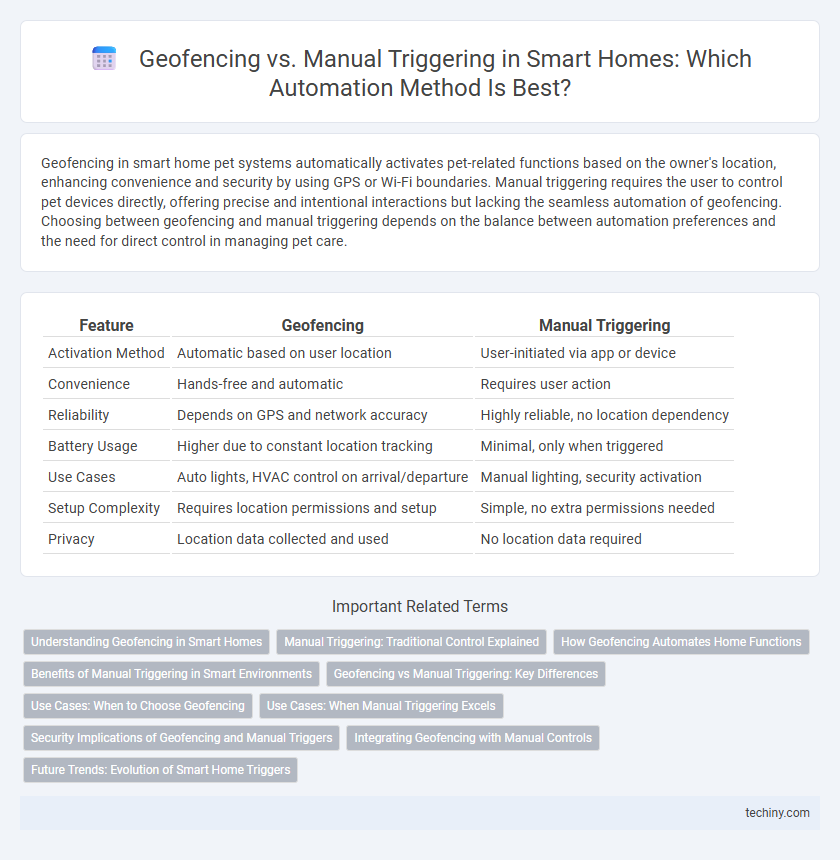Geofencing in smart home pet systems automatically activates pet-related functions based on the owner's location, enhancing convenience and security by using GPS or Wi-Fi boundaries. Manual triggering requires the user to control pet devices directly, offering precise and intentional interactions but lacking the seamless automation of geofencing. Choosing between geofencing and manual triggering depends on the balance between automation preferences and the need for direct control in managing pet care.
Table of Comparison
| Feature | Geofencing | Manual Triggering |
|---|---|---|
| Activation Method | Automatic based on user location | User-initiated via app or device |
| Convenience | Hands-free and automatic | Requires user action |
| Reliability | Depends on GPS and network accuracy | Highly reliable, no location dependency |
| Battery Usage | Higher due to constant location tracking | Minimal, only when triggered |
| Use Cases | Auto lights, HVAC control on arrival/departure | Manual lighting, security activation |
| Setup Complexity | Requires location permissions and setup | Simple, no extra permissions needed |
| Privacy | Location data collected and used | No location data required |
Understanding Geofencing in Smart Homes
Geofencing in smart homes uses GPS or RFID technology to create virtual boundaries that trigger automated actions when residents enter or leave a designated area. This technology enables seamless control of lighting, security systems, and HVAC settings without manual input, enhancing convenience and energy efficiency. Compared to manual triggering, geofencing offers real-time responsiveness and personalized automation based on occupants' location.
Manual Triggering: Traditional Control Explained
Manual triggering in smart homes involves users directly activating devices through physical switches, smartphone apps, or voice commands, providing precise and intentional control over home automation. Unlike geofencing, which relies on location-based triggers, manual control ensures actions are executed only when explicitly requested, minimizing accidental activations. This traditional control method remains essential for homeowners seeking predictable and hands-on management of lighting, security systems, and climate settings.
How Geofencing Automates Home Functions
Geofencing automates home functions by using GPS or RFID technology to create virtual boundaries around a property, triggering smart devices when a user enters or exits these zones. This technology enables automatic control of lighting, heating, security systems, and appliances without manual input, enhancing convenience and energy efficiency. Manual triggering requires user interaction, whereas geofencing provides seamless, hands-free automation based on location data.
Benefits of Manual Triggering in Smart Environments
Manual triggering in smart home environments offers precise control over device activation, ensuring actions occur exactly when desired without relying on location data. This method enhances security by allowing users to immediately respond to specific events or conditions, bypassing potential inaccuracies of geofencing technology. Manual controls also minimize false triggers, providing a reliable and user-driven smart home experience.
Geofencing vs Manual Triggering: Key Differences
Geofencing automates smart home actions by using GPS or RFID technology to trigger events when a user enters or leaves a predefined area, enhancing convenience and energy efficiency. Manual triggering, in contrast, requires users to activate devices through apps or physical switches, providing direct control but lacking automation benefits. Key differences include geofencing's reliance on location data for hands-free operation versus manual triggering's dependence on user input for precise timing.
Use Cases: When to Choose Geofencing
Geofencing is ideal for automating smart home actions based on location, such as turning off lights and adjusting thermostats when leaving home or unlocking doors upon arrival. It enhances convenience and energy efficiency by triggering devices without manual input, perfect for routines like daily commutes or vacation mode activation. Choose geofencing when automatic, location-based control improves security and comfort, especially in dynamic environments where manual triggering is impractical.
Use Cases: When Manual Triggering Excels
Manual triggering excels in scenarios requiring precise control and immediate response, such as turning on outdoor lights upon arriving home at night or activating security alarms during unexpected events. It is ideal for users who prefer direct interaction with their smart home devices, especially when automatic geofencing might cause false activations due to GPS inaccuracies or overlapping zones. This method enhances customization by allowing real-time adjustments based on specific needs, ensuring reliable and intentional device operation.
Security Implications of Geofencing and Manual Triggers
Geofencing enhances smart home security by automatically enabling alarms, locking doors, or activating cameras when occupants leave a predetermined perimeter, reducing reliance on human error in manual triggering. Manual triggers depend on user awareness and timely action, which can delay or prevent system activation during critical security events. Integrating geofencing with manual controls offers a layered defense, combining automated responses with user-initiated commands for optimal home protection.
Integrating Geofencing with Manual Controls
Integrating geofencing with manual controls creates a hybrid smart home system that optimizes automation and user flexibility. Geofencing uses GPS data to automatically trigger actions based on location, while manual controls allow precise adjustments for personalized preferences. This combination enhances convenience by enabling automatic responses when arriving or leaving, complemented by user-initiated commands for immediate control over devices like lighting, security, and climate.
Future Trends: Evolution of Smart Home Triggers
Geofencing is expected to evolve with enhanced AI integration, enabling smart homes to anticipate user needs based on precise location data and behavioral patterns. Manual triggering will remain relevant but increasingly complement automated systems through intuitive control interfaces like voice commands and gesture recognition. Future smart home triggers will emphasize seamless interaction between automated location-based cues and personalized manual inputs, driving a more adaptive and user-centric living environment.
Geofencing vs Manual Triggering Infographic

 techiny.com
techiny.com